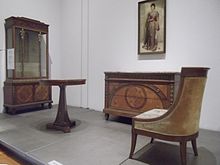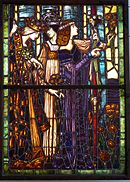Jakob Pallenberg

Jakob Pallenberg (born May 9, 1831 in Cologne , † March 25, 1900 in Cairo ) was a German furniture manufacturer who acted as a patron of the arts. He ran the carpentry trade at the transition to industrial production.
Life



Jakob Pallenberg is the son of Cäcilia Becker and the furniture manufacturer Johann Heinrich Pallenberg (1802–1884). Johann Heinrich Pallenberg was a specialist in art furniture , high-quality interior fittings and furnishings. Thanks to the use of the most modern machines - in 1836 he was the first Cologne business enterprise to purchase two steam engines to drive saws - the furniture manufacturer H. Pallenberg advanced to become one of the leading companies and supplier to the royal Prussian court and supplier to the royal court .
After his father withdrew from the company in 1861, Jakob and his brother Franz Pallenberg (1834–1882) took over the H. Pallenberg furniture manufacturer . Both sons had previously received a comparable training in furniture trade as their father, including a longer stay in Paris .
After the death of his brother Franz (1882), Jakob continued to run the largest furniture factory in Prussia with over 150 employees. Pallenberg set up a relief fund for workers in need. Like his father, Jakob Pallenberg was an important art patron and donated a large number of valuable art objects for Cologne museums. As a donor, he was committed to the new arts and crafts museum . In 1898 he commissioned the Berlin artist Melchior Lechter to design a splendid hall for the new house. Jakob Pallenberg did not live to see the completion of the “Pallenberg Hall”. During the Second World War , the “Pallenberg Hall” was destroyed on June 29, 1943, during a major Allied attack - like the entire building. Only one wing of the glass window, which is now on display in the collection of the Museum of Applied Arts Cologne, could be saved.
Jakob Pallenberg died unmarried in 1900 on a trip to Cairo. In his will he ordered 150,000 marks to be used for the expansion and furnishing of the Pallenberg Hall and 15,000 marks at the museum director's free disposal for the purchase of objects from the Pallenberg company warehouse. In addition, he bequeathed an amount of 200,000 marks to the city of Cologne, from the interest income of which art objects are to be purchased for the Museum of Decorative Arts .
In addition, Jakob Pallenberg donated 400,000 marks to set up a home for needy older workers, which was built in 1905–1912 in the form of a workers' settlement in Cologne-Weidenpesch . The "Jakob Pallenbergs Arbeiterheim" settlement was designed by the architects Hans Verbeek and Balduin Schilling in the form of a residential complex of 19 individual houses with kitchen gardens, two dormitories and a community house.
Jakob Pallenberg bequeathed valuable paintings from his estate to the Wallraf-Richartz Museum in Cologne, including the portrait of his father by Wilhelm Leibl . Jakob Pallenberg bequeathed foundation capital of over 850,000 marks to the city of Cologne.
In Cologne, Pallenbergstrasse and the Pallenberg housing estate were named after him. His grave is on the Melaten cemetery in Cologne (MA between lit. O and N) .
Picture gallery: "Jakob Pallenberg's Workers' Home"
literature
- Jürgen Weise: Pallenberg, Jakob. In: New German Biography (NDB). Volume 20, Duncker & Humblot, Berlin 2001, ISBN 3-428-00201-6 , p. 16 f. ( Digitized version ).
- Ulrich S. Soénius , Jürgen Wilhelm (Ed.): Kölner Personen Lexikon . Greven Verlag, Cologne 2008, ISBN 978-3-7743-0400-0 , p. 413-414 .
- Klara von Eyll: Leafed through Cologne address books . Greven Verlag, Cologne 1978, ISBN 3-7743-0160-3 , p. 59-61 .
Web links
- Bust of Jakob Pallenberg. Kulturelles-erbe-koeln.de
- Source of the month - June 2013. ihk-koeln.de
- Cabinet by Jakob Pallenberg (before 1876) in the German Digital Library
Individual evidence
- ^ Clara E. Laeis: Corporate Citizenship: entrepreneurial citizen competence in the service of a renewal of the social market economy: a concept for medium-sized companies. Writings of the Institute for Christian Social Sciences of the Westfälische Wilhelms-Universität Münster, Volume 53, Münster 2005, ISBN 978-3-8258-8630-1 , p. 79
- ^ Gerhard Dietrich: Museum of Applied Arts Cologne - Chronicle 1888 - 1988 . City of Cologne (ed.), Cologne 1988, p. 50
- ^ Gerhard Dietrich: Museum of Applied Arts Cologne - Chronicle 1888 to 1988 . MAKK and City of Cologne (eds.), Cologne 1988, sheet 1943
- ↑ Speech by Lord Mayor Jürgen Roters on the occasion of the ceremony to mark the 125th anniversary of the Museum of Applied Arts Cologne on June 10, 2013, 7 p.m., MAKK. (PDF) stadt-koeln.de; accessed on August 9, 2015
- ^ Gerhard Dietrich: Museum of Applied Arts Cologne - Chronicle 1888 - 1988 . City of Cologne (ed.), Cologne 1988, p. 44 f.
- ↑ Workers' settlement with bay windows and turrets. ksta.de; Retrieved August 9, 2014
- ^ Pallenbergsiedlung in Cologne Weidenpesch. bilderbuch-koeln.de; Retrieved August 9, 2014
- ↑ Detlef Rick: Melaten - graves tell history . Emons, Cologne, ISBN 978-3-89705-789-0 , pp. 68 .
| personal data | |
|---|---|
| SURNAME | Pallenberg, Jakob |
| ALTERNATIVE NAMES | Pallenberg, Jacob |
| BRIEF DESCRIPTION | German cabinet maker and patron |
| DATE OF BIRTH | May 9, 1831 |
| PLACE OF BIRTH | Cologne |
| DATE OF DEATH | March 25, 1900 |
| Place of death | Cairo |






